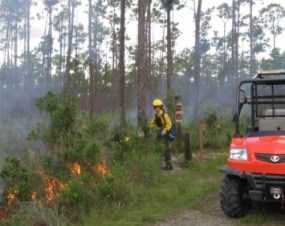
Fire and Water Both Shape the Everglades Everglades National Park strives to maintain the biological diversity and natural processes of a landscape shaped by the interaction of fire and water. Using fire as a management tool we accomplish this goal. Management-Ignited Wildland Fire Lightning-Ignited Wildland Fire Wildland Fire in Everglades National Park 1. Dry Season Short days with mild temperatures and low to moderate humidity are normal during this period, with minimal rain or water flow into the park. Water flows, soil moistures, and live fuel moisture drop, and the Keetch Byram Drought Index (KBDI) generally continues to raise until the start of the transition season. Lightning is rare, and fires are generally human-caused. Significant fire suppression problems can be caused by passing cold fronts, freezes, or severe drought. Fires are likely to holdover due to low humidity recovery and will likely burn to water or to 1-2 year old burn scars. Hammock and/or peat fires are a concern due to continued drying and partial detrimental fire effects. 2. Transition Season This is the transition between the true dry and wet seasons. It generally starts around the 3rd week of May. Days are long and hot, with humidity ranging from dry to wet. Rain is common, but comes in the form of scattered thunderstorms that clear quickly. Most areas received rain 2-4 days/week, but it is not uncommon for areas to go 5 or more days without rain. Water levels, soil moistures, and live fuel moistures are variable due to the variable nature of rain and humidity. Naturally occurring fires are common due to extensive lightning activity, but generally are easily managed except when the onset of the summer rains is delayed, there is a severe long-term drought, and/or there is a short-term drought. Fires may holdover due to low humidity recovery, but often are extinguished by humidity recovery passing rain. Hammocks and peat can be a concern whenever there have been 5 or more days without rain and/or water levels are unusually low. Fire generally burn to water or 1-2 year burn scars, or until extinguished by humidity recovery or rain. 3. Wet Season Days are long, hot, and generally humid. Rain from thunderstorms and tropical storms is common and is often heavy. Water levels, soil moistures, and live fuel moistures generally peak during this period. Lightning activity remains high in the early portion of the period, but fire occurrence is relatively low due to wet weather conditions. Fires are generally limited to highest portions of the park and generally do not holdover. |
Last updated: September 3, 2015
